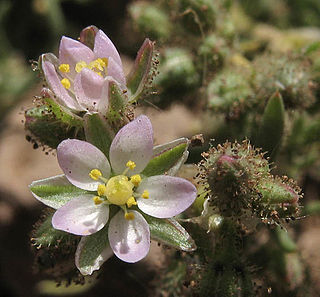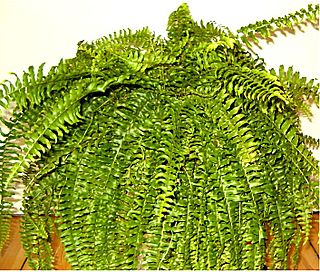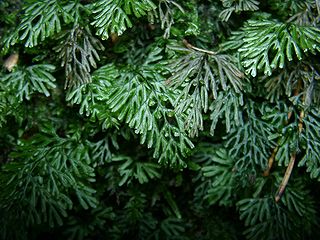
Caryophyllaceae, commonly called the pink family or carnation family, is a family of flowering plants. It is included in the dicotyledon order Caryophyllales in the APG III system, alongside 33 other families, including Amaranthaceae, Cactaceae, and Polygonaceae. It is a large family, with 81 genera and about 2,625 known species.

Coreopsis is a genus of flowering plants in the family Asteraceae. Common names include calliopsis and tickseed, a name shared with various other plants.

Spergularia is a genus in the family Caryophyllaceae, containing salt-tolerant plants known as sandspurrys and sea-spurreys. There are about 60 species.

Spergularia bocconei, Boccone's sandspurry, Greek sea-spurrey or Boccone's sea-spurrey, is a species of the genus Spergularia, in the family Caryophyllaceae. It is named after the Sicilian botanist Paolo Boccone. Scheele first published it as Alsine bocconi in 1843. It was transferred to the genus Spergularia by Graebner in 1919. Pedersen placed the species in genus Spergula in 1984.

Polystichum is a genus of ferns in the family Dryopteridaceae, subfamily Dryopteridoideae, according to the Pteridophyte Phylogeny Group classification of 2016. The genus has about 500 species and has a cosmopolitan distribution. The highest diversity is in eastern Asia, with about 208 species in China alone; the region from Mexico to Brazil has at least 100 additional species; Africa, North America, and Europe have much lower diversity. Polystichum species are terrestrial or rock-dwelling ferns of warm-temperate and montane-tropical regions. They are often found in disturbed habitats such as road cuts, talus slopes, and stream banks.

Nephrolepis is a genus of about 30 species of ferns. It is the only genus in the family Nephrolepidaceae, placed in the suborder Aspleniineae of the order Polypodiales in the Pteridophyte Phylogeny Group classification of 2016. The genus is commonly referred to as macho ferns or swordferns.

Microchilus is a neotropical genus of about 75 species belonging to the orchid family (Orchidaceae).

Spergula arvensis, the corn spurry, stickwort, starwort or spurrey, is a species of plant in the genus Spergula.

The Hymenophyllaceae, the filmy ferns and bristle ferns, are a family of two to nine genera and about 650 known species of ferns, with a subcosmopolitan distribution, but generally restricted to very damp places or to locations where they are wetted by spray from waterfalls or springs. A recent fossil find shows that ferns of Hymenophyllaceae have existed since at least the Upper Triassic.

Lotononis is a genus of flowering plants in the family Fabaceae and the tribe Crotalarieae. Almost all of the species in the genus occur in southern Africa.

Eleocharis is a virtually cosmopolitan genus of 250 or more species of flowering plants in the sedge family, Cyperaceae. The name is derived from the Greek words ἕλειος (heleios), meaning "marsh dweller," and χάρις (charis), meaning "grace." Members of the genus are known commonly as spikerushes or spikesedges. The genus has a geographically cosmopolitan distribution, with centers of diversity in the Amazon Rainforest and adjacent eastern slopes of the South American Andes, northern Australia, eastern North America, California, Southern Africa, and subtropical Asia. The vast majority of Eleocharis species grow in aquatic or mesic habitats from sea level to higher than 5,000 meters in elevation.

Trichomanes is a genus of ferns in the family Hymenophyllaceae, termed bristle ferns. The circumscription of the genus is disputed. All ferns in the genus are filmy ferns, with leaf tissue typically 2 cells thick. This thinness generally necessitates a permanently humid habitat, and makes the fronds somewhat translucent. Because of this membrane-like frond tissue, the plant is prone to drying out. “Filmy ferns” in the taxa Hymenophyllaceae grow in constantly wet environments. Many are found in cloud forests such as “Choco” in Columbia. There are also members of the taxa that can grow submersed in water.

Sagina is a genus of 20–30 species of flowering plants in the family Caryophyllaceae. These are flowering herbs native to temperate regions of the Northern Hemisphere extending south to tropical mountain areas at high altitudes, reaching just south of the equator in Africa. They are small annual or perennial herbaceous plants, growing to 5–15 cm. The leaves are opposite, often in tight whorl-like clusters, simple linear, typically 5–20 mm long. The flowers are solitary or in small cymes, with four or five green sepals and an equal number of white petals; the petal size relative to the sepal size is useful in species identification. The fruit is a small capsule containing several seeds.

Microgramma is a genus of ferns in the family Polypodiaceae, subfamily Polypodioideae, according to the Pteridophyte Phylogeny Group classification of 2016 (PPG I). They are commonly known as vine ferns or snakeferns.

Argyrolobium is a genus of flowering plants in the family Fabaceae. It belongs to the subfamily Faboideae. Members of this genus are found in Africa and south Asia.

Sagina procumbens is a species of flowering plant. in the family Caryophyllaceae known by the common names procumbent pearlwort, birdeye pearlwort and matted pearlwort. It can be found throughout the Northern Hemisphere and parts of South America. It is a common weed of many environments. It can be found in wild and disturbed habitat, especially moist areas. It can sometimes be seen growing in lawns or in cracks in the sidewalk. This is a perennial herb forming clumps or mats of hairless green herbage, sometimes vaguely resembling a patch of moss. The leaves are linear and up to 1 or 2 centimeters long. The inflorescence is a solitary flower with four or five sepals and four or five small white petals, but the petals are sometimes absent.

Spergularia marina, also called Spergularia salina, is a species of flowering plant in the family Caryophyllaceae. It is known as salt sandspurry or lesser sea-spurrey. S. marina is a sprawling annual or sometimes perennial, with stems up to 35 cm (14 in) long. Like other sea-spurrey species, its flowers have white to pink petals, with sepals usually longer than the petals, at 2.5–4 mm (0.1–0.2 in). Plants are salt-tolerant, being found by the sea and in saline areas inland.

















